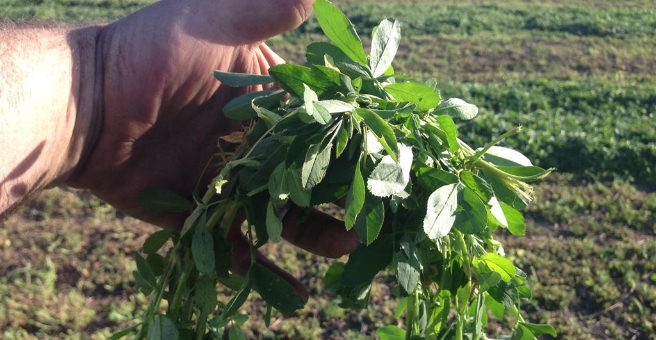Part locator

High Moisture Hay: 4 Nutrients in Hay That Require Fast Moisture Removal
February 17, 2023
LEARN MORE
High-quality hay is critical for maintaining a healthy herd and maximizing cattle production. Since hay quality is determined by the nutrients available, you need to know how best to dry hay without losing these vital nutrients.
While there are conditioner rolls from B&D Rollers, processes such as tedding and conditioning can help speed up drying time, as dry matter loss can occur at any time. To ensure you don’t have high moisture hay, nutritional changes, and reduced forage quality, contact our sales team.
Though some loss is inevitable, learning the drying process of each nutrient can help avoid baling high moisture hay and improve the quality of the final product.
Understanding Nutrients in Hay and the Effects of High Moisture Hay

Alfalfa and living pasture grasses are rich in protein, carbohydrates, minerals, essential fatty acids, water-soluble vitamins, and fat. Though good soil helps maintain these nutrients, they begin to dwindle once you cut and dry the hay.
Shortening the time to dry hay and understanding how losses occur throughout the process can help maintain high-quality hay. One of the most damaging elements to hay quality is rain, especially when it occurs a day or two after the cutting process when the risk of leaching losses is higher.
Water-Soluble Vitamins
Vitamin C is the most water-soluble and unstable vitamin. Unlike vitamin B, which takes longer to diminish and only tapers off over time, vitamin C oxidizes quickly. Though the healthy liver of an animal can produce vitamin C, you need to ensure that the hay maintains adequate levels of vitamin C. This means fast moisture removal.
Allow hay bales to dry sufficiently to stop the plant’s metabolic process. Once the hay has moisture levels below 30%, respiration will reduce to an acceptable level, and you will be able to maintain the water-soluble vitamins.
When you bale hay, and it is rained on when it’s relatively green, it will respire for a longer time. This will result in reduced dry matter yield and loss of forage nutrients.

Fat-Soluble Vitamins
These nutrients include vitamins E, D, K, and A, also known as beta-carotene. Vitamins E and A can be quickly destroyed or oxidized shortly after cutting because they are exposed to moisture, light, air, and heat.
Therefore, to maintain this nutrient, you must remove moisture quickly and learn how to store the hay. Though vitamin K also diminishes, the hindgut bacteria can produce the vitamin K an animal needs unless their microbial population is low due to antibiotics or an illness.
Curing hay in the sun doesn’t maintain a sufficient amount of vitamin D; the longer you store the hay, the less it will have. However, if the animal is exposed to enough sun, it will not require any vitamin D supplementation.
Essential Fatty Acids (EFAs)
Alfalfa and fresh grass are rich in alpha-linolenic acid (ALA) and linoleic acid (LA). However, hay loses these two critical amino acids during the drying and storing process. Since animals require these nutrients, knowing how to best maintain these are essential.
Regardless of the species of grass, fresh hay has similar acid patterns. 50% of the total acid content is linolenic acid. When exposed to a lot of moisture, the linolenic acid content in hay can reduce to 18.5%. Therefore, to preserve the content of essential fatty acids, use the right conditioning method and the correct machinery.
Minerals and Proteins
These two nutrients remain at the same level as pasture. However, starch, fructans, and simple sugars decline once you cut the grass. These changes are due to carbohydrates retaining some enzymatic metabolism until no moisture supports it.
Fresh-cut hay mostly has a moisture level of 80%. This also means that the loss of sugar, starch and respiration continues even after hay is cut. Hay needs to lose at least 65% of moisture before it is ready to bale. When you shorten the amount of time it takes to cut the hay and go from 80% to under 40% moisture, you will increase the quality of the end product.
Hay loses the first 10% of moisture through the stomates, which are small spaces in the plant’s leaves that regulate its temperature through water loss. Stomates only open in light and close in the middle of a thick swath at night.
The drying process will slow down if the light cannot penetrate the swath. Therefore, to ensure you don’t bale high moisture hay and maintain proteins and minerals, you should consider having a wider swath.
Learn How to Maintain Nutrients in Hay
Animals rely on high forage quality and good hay for good health. Since the loss of nutrients can occur during the drying process and storage, it is crucial to learn how to handle hay, especially in avoiding high moisture hay, and what to do to maintain these vital nutrients.
At B&D Rollers, we have the ultimate in hay conditioning rollers to help you harvest the highest quality hay. Our rollers help enhance the condition of your hay from start to finish, from the field to the cutting process and storage, ensuring that high moisture content is avoided. Get in touch with us today to discover how our hay conditioning rollers can transform your hay drying process and produce the best results for quicker drying hay.
You Might Also Like...
AVAILABLE WORLDWIDE
USA, Canada, Mexico, Australia
No matter where you are, there’s a Crusher near you.
FIND A DEALER











